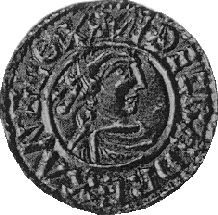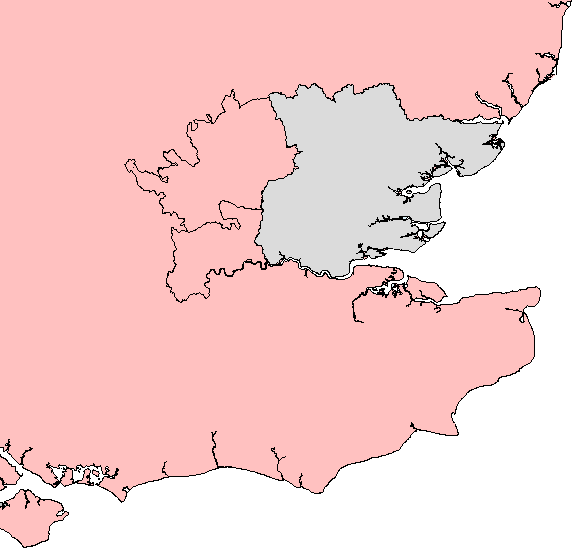|
ֳ†thelwold ֳ¦theling
ֳ†thelwold () or ֳ†thelwald (died 13 December 902) was the younger of two known sons of ֳ†thelred I, King of Wessex from 865 to 871. ֳ†thelwold and his brother ֳ†thelhelm were still infants when their father the king died while fighting a Danish Viking invasion. The throne passed to the king's younger brother (ֳ†thelwold's uncle) Alfred the Great, who carried on the war against the Vikings and won a crucial victory at the Battle of Edington in 878. After Alfred's death in 899, ֳ†thelwold disputed the throne with Alfred's son, Edward the Elder. As senior ֳ¦theling (prince of the royal dynasty eligible for kingship), ֳ†thelwold had a strong claim to the throne. He attempted to raise an army to support his claim, but was unable to get sufficient support to meet Edward in battle and fled to Viking-controlled Northumbria, where he was accepted as king. In 901 or 902 he sailed with a fleet to Essex, where he was also accepted as king. The following year ֳ†thelwold persuaded the Eas ... [...More Info...] [...Related Items...] OR: [Wikipedia] [Google] [Baidu] |
England 878
England is a country that is part of the United Kingdom. It is located on the island of Great Britain, of which it covers about 62%, and more than 100 smaller adjacent islands. It shares a land border with Scotland to the north and another land border with Wales to the west, and is otherwise surrounded by the North Sea to the east, the English Channel to the south, the Celtic Sea to the south-west, and the Irish Sea to the west. Continental Europe lies to the south-east, and Ireland to the west. At the 2021 census, the population was 56,490,048. London is both the largest city and the capital. The area now called England was first inhabited by modern humans during the Upper Paleolithic. It takes its name from the Angles, a Germanic tribe who settled during the 5th and 6th centuries. England became a unified state in the 10th century and has had extensive cultural and legal impact on the wider world since the Age of Discovery, which began during the 15th century. The K ... [...More Info...] [...Related Items...] OR: [Wikipedia] [Google] [Baidu] |
Michael Lapidge
Michael Lapidge, FBA (born 8 February 1942) is a scholar in the field of Medieval Latin literature, particularly that composed in Anglo-Saxon England during the period 600ג€“1100 AD; he is an emeritus Fellow of Clare College, Cambridge, a Fellow of the British Academy, and winner of the 2009 Sir Israel Gollancz Prize. Education and career Lapidge completed his B.A. at the University of Calgary and taught there for three years after completing an M.A. (U of Alberta), before going to the University of Toronto in 1967 to begin work on a Ph.D. in the Centre for Medieval Studies. His doctoral dissertation, supervised by Brian Stock, studied the transmission of a nexus of cosmological metaphors, first articulated by Greek Stoic philosophers, to classical and late antique Latin poets, and ultimately to Medieval Latin philosophers and poets of the twelfth century. After completing course-work in Toronto, he went to Cambridge in 1969 to have better access to manuscript depositories w ... [...More Info...] [...Related Items...] OR: [Wikipedia] [Google] [Baidu] |
Treaty Of Alfred And Guthrum
The Treaty of Alfred and Guthrum is a 9th-century peace agreement between Alfred of Wessex and Guthrum, the Viking ruler of East Anglia. It sets out the boundaries between Alfred and Guthrum's territories as well as agreements on peaceful trade, and the ''weregild'' value of its people. Background In 866, the Great Heathen Army landed in East Anglia with the intention of conquering all of the English kingdoms. During its campaign, the Viking army conquered the kingdoms of East Anglia, Mercia, and Northumbria. It initially overran the Kingdom of Wessex, but Danish King Guthrum was defeated by Alfred's army at the Battle of Edington in 878. Under the terms of his surrender, shortly afterward, Guthrum was obliged to be baptised to endorse the agreement, as well as to allow him to rule more legitimately over his Christian vassals but remaining pagan to his pagan vassals. He was then with his army to leave Wessex. That agreement is known as the Treaty of Wedmore. Sometime after ... [...More Info...] [...Related Items...] OR: [Wikipedia] [Google] [Baidu] |
Somerset Levels
The Somerset Levels are a coastal plain and wetland area of Somerset, England, running south from the Mendips to the Blackdown Hills. The Somerset Levels have an area of about and are bisected by the Polden Hills; the areas to the south are drained by the River Parrett, and the areas to the north by the rivers Axe and Brue. The Mendip Hills separate the Somerset Levels from the North Somerset Levels. The Somerset Levels consist of marine clay "levels" along the coast and inland peat-based "moors"; agriculturally, about 70 per cent is used as grassland and the rest is arable. Willow and teazel are grown commercially and peat is extracted. A Palaeolithic flint tool found in West Sedgemoor is the earliest indication of human presence in the area. The Neolithic people exploited the reed swamps for their natural resources and started to construct wooden trackways, including the world's oldest known timber trackway, the Post Track, dating from about 3800 BC. The Le ... [...More Info...] [...Related Items...] OR: [Wikipedia] [Google] [Baidu] |
Primogeniture
Primogeniture () is the right, by law or custom, of the firstborn Legitimacy (family law), legitimate child to inheritance, inherit all or most of their parent's estate (law), estate in preference to shared inheritance among all or some children, any illegitimate child or any collateral relative. In most contexts, it means the inheritance of the firstborn son (agnatic primogeniture); it can also mean by the firstborn daughter (matrilineal primogeniture), or firstborn child (absolute primogeniture). Its opposite analogue is partible inheritance. Description The common definition given is also known as male-line primogeniture, the classical form popular in European jurisdictions among others until into the 20th century. In the absence of male-line offspring, variations were expounded to entitle a daughter or a brother or, in the absence of either, to another collateral relative, in a specified order (e.g., male-preference primogeniture, Salic primogeniture, semi-Salic primogenitu ... [...More Info...] [...Related Items...] OR: [Wikipedia] [Google] [Baidu] |
Great Heathen Army
The Great Heathen Army, also known as the Viking Great Army,Hadley. "The Winter Camp of the Viking Great Army, AD 872ג€“3, Torksey, Lincolnshire", ''Antiquaries Journal''. 96, pp. 23ג€“67 was a coalition of Scandinavian warriors who invaded England in 865 AD. Since the late 8th century, the Vikings had been engaging in raids on centres of wealth, such as monasteries. The Great Heathen Army was much larger and aimed to conquer and occupy the four kingdoms of East Anglia, Northumbria, Mercia and Wessex. The name ''Great Heathen Army'' is derived from the '' Anglo-Saxon Chronicle''. The force was led by three of the five sons of the semi-legendary Ragnar Lodbrok, including Halfdan Ragnarsson, Ivar the Boneless and Ubba. The campaign of invasion and conquest against the Anglo-Saxon kingdoms lasted 14 years. Surviving sources give no firm indication of its numbers, but it was described as amongst the largest forces of its kind. The invaders initially landed in East Ang ... [...More Info...] [...Related Items...] OR: [Wikipedia] [Google] [Baidu] |
ֳ†thelberht Of Wessex
ֳ†thelberht, Aethelbert or Ethelbert is a masculine given name which may refer to: People ֳ†thelberht * ֳ†thelberht of Kent (c. 550ג€“616), King of Kent * ֳ†thelred and ֳ†thelberht (died c. 669), possibly legendary princes of Kent, saints and martyrs * ֳ†thelberht, king of the Hwicce () * ֳ†thelbert of Sussex (), King of Sussex * Alberht of East Anglia (8th century), also ֳ†thelberht I of East Anglia, ruler of East Anglia * ֳ†thelbert II of Kent (725ג€“762), King of Kent * ֳ†thelbert of York (died 780), Archbishop of York, scholar and teacher * ֳ†thelberht II of East Anglia (died 794), saint and King of East Anglia * ֳ†thelberht of Whithorn (died 797), Bishop of Whithorn * ֳ†thelberht, King of Wessex (died 865) Ethelbert * Ethelbert Barksdale (1824ג€“1893), American and Confederate politician * Ethelbert Blatter (1877ג€“1934), Swiss Jesuit priest and pioneering botanist in British India * E. W. Bullinger (1837ג€“1913), Anglican clergyman, biblical scholar and theologian * ... [...More Info...] [...Related Items...] OR: [Wikipedia] [Google] [Baidu] |
ֳ†thelbald Of Wessex
ֳ†thelbald (also Ethelbald or Aethelbald) may refer to: * ֳ†thelbald of Mercia, King of Mercia, 716ג€“757 * ֳ†thelbald, King of Wessex, 856ג€“860 * ֳ†thelbald of York, Archbishop of York, 900ג€“904 * ֳ†thelbald (bishop), bishop of Sherborne (died between 918 and 925) {{DEFAULTSORT:Aethelbald ... [...More Info...] [...Related Items...] OR: [Wikipedia] [Google] [Baidu] |
Viking
Vikings were seafaring people originally from Scandinavia (present-day Denmark, Norway, and Sweden), who from the late 8th to the late 11th centuries raided, pirated, traded, and settled throughout parts of Europe.Roesdahl, pp. 9ג€“22. They also voyaged as far as the Mediterranean Sea, Mediterranean, North Africa, the Middle East, Greenland, and Vinland (present-day Newfoundland in Canada, North America). In their countries of origin, and some of the countries they raided and settled in, this period is popularly known as the Viking Age, and the term "Viking" also commonly includes the inhabitants of the Scandinavian homelands as a whole. The Vikings had a profound impact on the Early Middle Ages, early medieval history of Northern Europe, northern and Eastern Europe, including the political and social development of England (and the English language) and parts of France, and established the embryo of Russia in Kievan Rus'. Expert sailors and navigators of their cha ... [...More Info...] [...Related Items...] OR: [Wikipedia] [Google] [Baidu] |
Kingdom Of Essex
The Kingdom of the East Saxons (; ), referred to as the Kingdom of Essex , was one of the seven traditional kingdoms of the Anglo-Saxon Heptarchy. It was founded in the 6th century and covered the territory later occupied by the counties of Essex, Middlesex, much of Hertfordshire and (for a short while) west Kent. The last king of Essex was Sigered of Essex, who in 825 ceded the kingdom to Ecgberht, King of Wessex. Extent The Kingdom of Essex was bounded to the north by the River Stour and the Kingdom of East Anglia, to the south by the River Thames and Kent, to the east lay the North Sea and to the west Mercia. The territory included the remains of two provincial Roman capitals, Colchester and London. The kingdom included the Middle Saxon Province, which included the area of the later County of Middlesex and most, if not all, of Hertfordshire Although the province is ever recorded only as part of the East Saxon Kingdom, charter evidence shows that it was not part of its co ... [...More Info...] [...Related Items...] OR: [Wikipedia] [Google] [Baidu] |
Kingdom Of Sussex
The Kingdom of the South Saxons, today referred to as the Kingdom of Sussex (; from , in turn from or , meaning "(land or people of/Kingdom of) the South Saxons"), was one of the seven traditional kingdoms of the Heptarchy of Anglo-Saxon England. On the south coast of the island of Great Britain, it was originally a sixth-century Saxon colony and later an independent Realm, kingdom. The kingdom remains one of the least known of the Anglo-Saxon polities, with no surviving king-list, several local rulers and less centralisation than other Anglo-Saxon kingdoms. The South Saxons were ruled by the kings of Sussex until the country was annexed by Wessex, probably in 827, in the aftermath of the Battle of Ellendun. In 860 Sussex was ruled by the kings of Wessex, and by 927 all remaining heptarchy, Anglo-Saxon kingdoms were ruled by them as part of the new kingdom of England. The foundation legend of the kingdom of Sussex is that in 477 ֳ†lle of Sussex, ֳ†lle and his three sons arrived ... [...More Info...] [...Related Items...] OR: [Wikipedia] [Google] [Baidu] |





